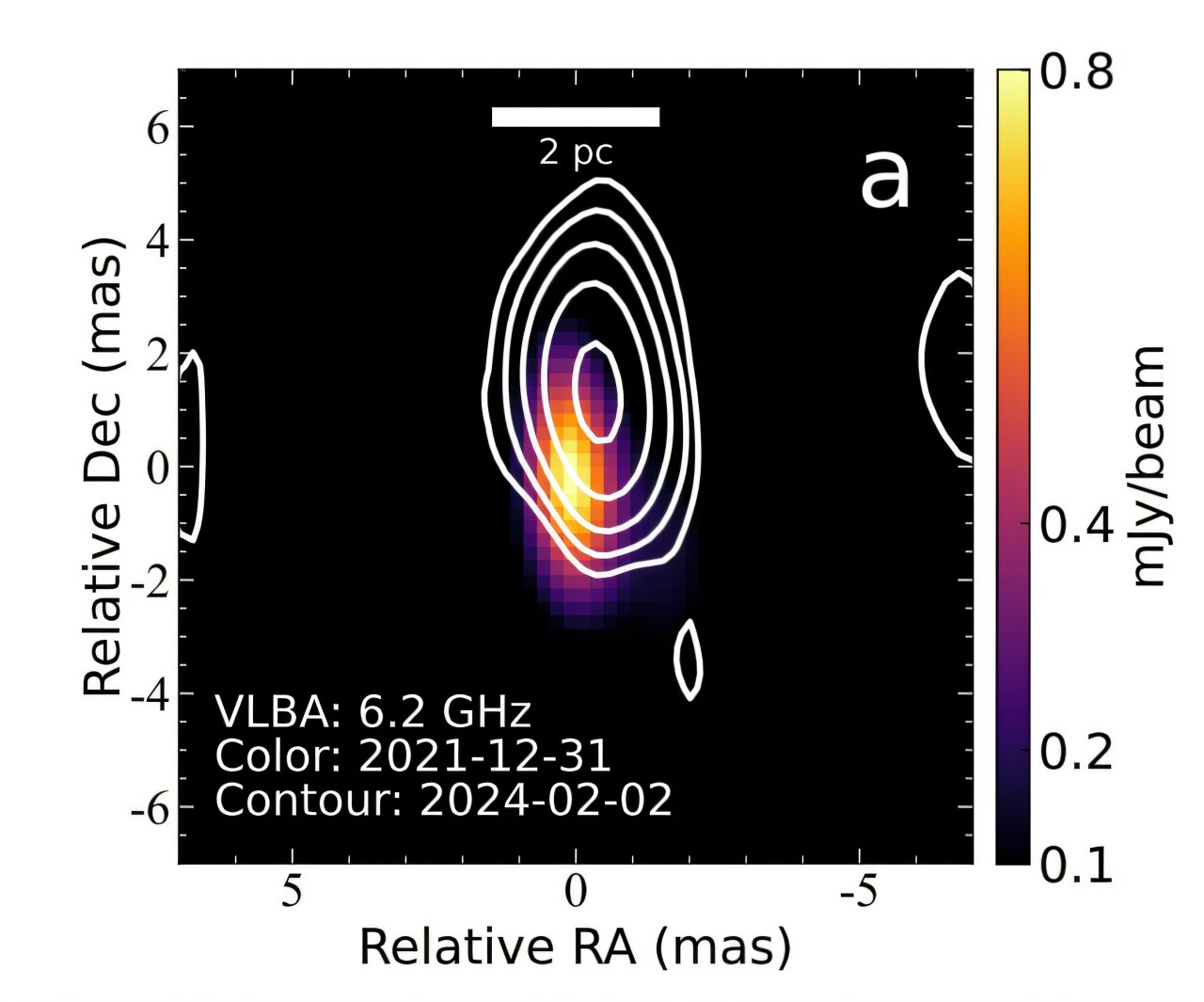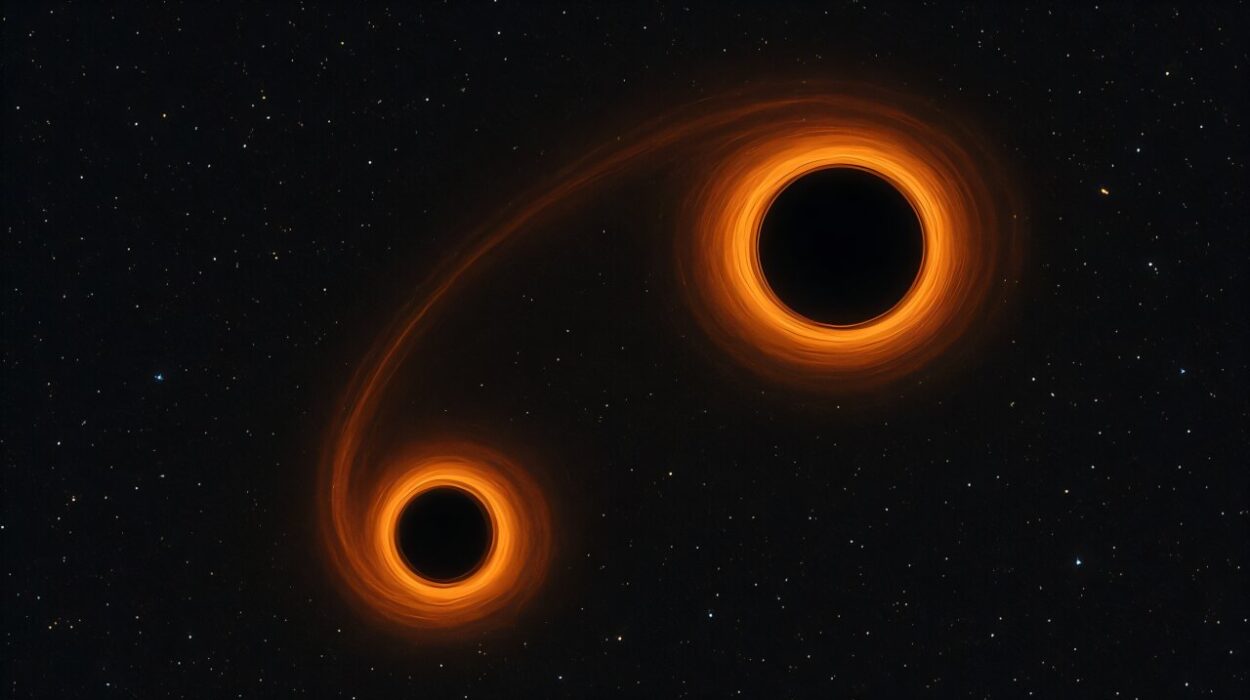In the heart of a seemingly quiet galaxy some 500 million light-years away, astronomers have uncovered a cosmic cannon firing matter at near-light speed—shattering the notion that radio-quiet galaxies always live up to their name.
The discovery, unveiled in a research paper published June 4 on the arXiv pre-print server, centers on Markarian 110, a peculiar active galaxy that has suddenly become the stage for a spectacular celestial performance. Using the ultra-precise eye of Very Long Baseline Interferometry (VLBI), scientists have captured what many thought improbable: a relativistic jet, blazing out from the core of a galaxy long believed to be one of the cosmic wallflowers.
But Markarian 110—or Mrk 110—is no longer sitting quietly at the galactic sidelines. Its newly revealed jet, moving at a speed so great it appears to outpace light (a phenomenon called superluminal motion), offers not just a surprise, but a challenge to astronomers’ long-standing models of how and where such jets are born.
A Silent Galaxy Roars to Life
To understand why this finding is extraordinary, it’s important to grasp what makes Mrk 110 unique in the first place. It belongs to a rare class of galaxies known as narrow-line Seyfert 1 (NLS1) galaxies, which are already strange creatures of the cosmos. They host black holes that are smaller and spin faster than their counterparts in other active galaxies, and they exhibit a dazzling, often erratic behavior across wavelengths—from X-rays to visible light.
Mrk 110 has long been labeled “radio-quiet,” a term that suggests a lack of powerful jet activity. For years, it looked the part. Its radio signals were faint. Its core seemed dormant. Yet, its chaotic shape—a warped, irregular structure—hints at a past filled with galactic mergers or cosmic collisions. It’s as if the galaxy was whispering secrets, waiting for the right ears to listen.
Enter the Very Long Baseline Array (VLBA) and the European VLBI Network (EVN), two networks of radio telescopes spaced across continents. By combining data from these distant observatories, astronomers can generate images with such precision, they can see details as fine as a grain of sand from thousands of miles away.
Between 2015 and 2024, a team of astronomers led by Ailing Wang of the Chinese Academy of Sciences aimed these instruments at Mrk 110 at multiple frequencies—1.6, 4.7, 4.9, and 7.6 GHz. What they found was far from quiet.
A Jet with Superluminal Speed
The VLBI observations revealed two distinct bursts of jet activity: the first between 2015 and 2016, and the second between 2022 and 2024. These weren’t faint flickers or anomalies. In fact, by early 2024, the jet had shifted position significantly and was moving with apparent superluminal velocity—a visual illusion that occurs when objects approach light speed in a direction close to our line of sight.
The measured proper motion of the jet was 0.6 milliarcseconds per year, which translates into velocities that, on cosmic scales, border on the surreal. For a galaxy previously thought incapable of launching such high-speed outflows, this was a revelation.
The jet, though powerful, doesn’t stretch endlessly into space. It begins to decelerate around 10 to 20 light-years from the galactic core. But that slowdown is itself a goldmine of information. As the jet loses speed, its radio spectrum morphs in a dramatic fashion—shifting from a steep to an inverted spectral index. This behavior perfectly mirrors what theoretical models predict for newborn jets enveloped in their own cloud of synchrotron radiation.
Put simply, the spectrum reveals the jet’s life story: a burst of material launched with enormous energy, cloaked in its own magnetic fog, and eventually thinning as it travels outward—like a rocket shedding stages as it leaves Earth’s atmosphere.
A New Puzzle in Jet Physics
What could possibly trigger such jet eruptions in a galaxy not known for them? That’s the question now stirring imaginations across the astrophysical community.
The research team points to a perfect storm of astrophysical conditions: a rapidly spinning black hole, a high accretion rate (which means the black hole is feasting greedily on surrounding matter), and periodic build-ups of magnetic flux that suddenly snap and release energy, like a rubber band stretched too far.
These so-called magnetic flux accumulation and dissipation cycles could be the ticking clock behind the sporadic jet outbursts observed in Mrk 110. Think of them as cosmic heartbeats—intense, powerful, and irregular.
This discovery forces scientists to revisit their assumptions about which galaxies can launch relativistic jets. For decades, it was thought that only radio-loud AGNs, especially those hosted in giant elliptical galaxies, could produce such ferocious outflows. But Mrk 110 is none of those things. It’s messy. It’s erratic. And now, it’s loud.
Implications for the Wider Universe
Beyond the spectacle, this finding has profound implications for understanding galaxy evolution and the role of supermassive black holes in shaping the cosmos.
Jets are not just fascinating phenomena; they are galactic architects. By blasting matter and energy across thousands of light-years, they can regulate star formation, influence the shape of galaxies, and distribute heavy elements throughout the intergalactic medium.
If radio-quiet galaxies like Mrk 110 can intermittently become jet-producers, it means our census of cosmic jet-makers is woefully incomplete. There may be thousands—perhaps millions—of other galaxies with hidden histories of jet activity that we’ve simply overlooked.
And that opens up an exciting new chapter in the study of AGN feedback—the process by which black holes affect their host galaxies. Mrk 110 may become a cornerstone example of how even the “quiet” parts of the universe can sometimes shout.
The Quiet That Wasn’t
In the end, the story of Markarian 110 reminds us that the cosmos is full of surprises. A galaxy that once whispered has now roared. A black hole that once seemed content has revealed a powerful, secret heartbeat. And a scientific community that once thought it knew what to expect from radio-quiet AGNs has been given a thrilling new challenge.
Astronomy, after all, is a science built on light—its paths, its pulses, its flickers across time and space. And with each new photon caught by an Earthbound dish, the universe whispers its secrets.
Sometimes, it even shouts.
Reference: Ailing Wang et al, A Relativistic Jet in the Radio Quiet AGN Mrk 110, arXiv (2025). DOI: 10.48550/arxiv.2506.03970






